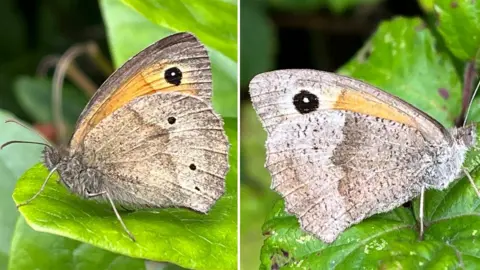Butterflies could lose spots as climate warms - Exeter University researchers
 Professor Richard ffrench-Constant
Professor Richard ffrench-ConstantClimate change could be making butterflies less spotty, according to researchers.
Scientists at the University of Exeter have been studying the effects of temperature on the wing markings of female meadow brown butterflies.
They found females that developed at 11C (52F) had six spots on average, while those developing at 15C (59F) had just three.
They said this challenged long-held views about butterfly spot numbers.
'Adapting camouflage'
Professor Richard ffrench-Constant, from the Centre for Ecology and Conservation on Exeter's Penryn Campus in Cornwall, said: "Meadow Browns always have large 'eyespots' on their forewings, probably for startling predators.
"They also have smaller spots on their hindwings, probably useful for camouflage when the butterfly is at rest.
"Our findings show that fewer of these hindwing spots appear when females experience higher temperatures during their pupal stage.
"This suggests the butterflies adapt their camouflage based on the conditions.
"For example, with fewer spots they may be harder to spot on dry, brown grass that would be more common in hot weather."
The researchers said they were predicting that spotting would decrease year-on-year as the climate warmed.
Professor ffrench-Constant added: "This is an unexpected consequence of climate change.
"We tend to think about species moving north, rather than changing appearance."

Follow BBC News South West on Twitter, Facebook and Instagram. Send your story ideas to [email protected].
